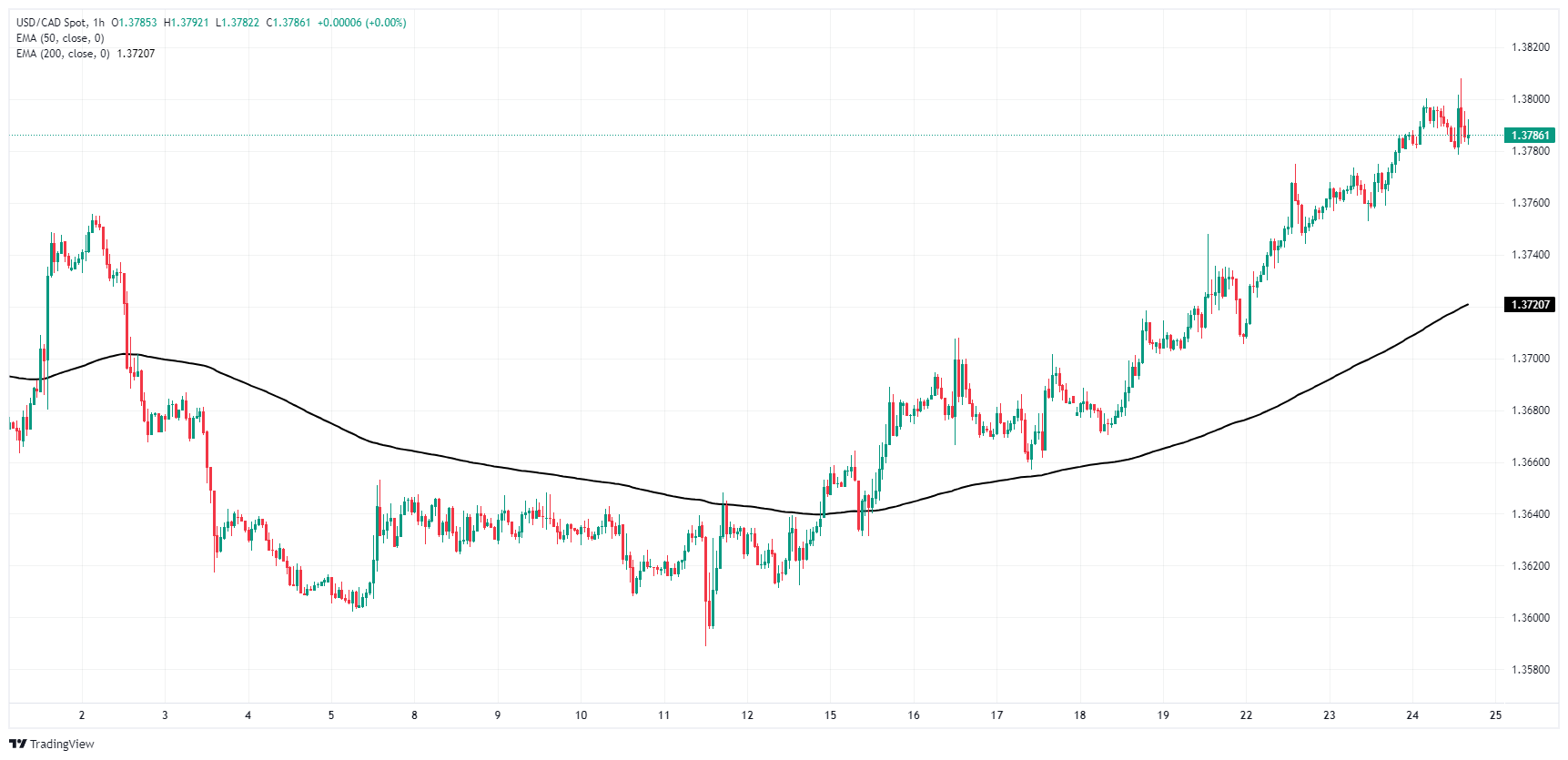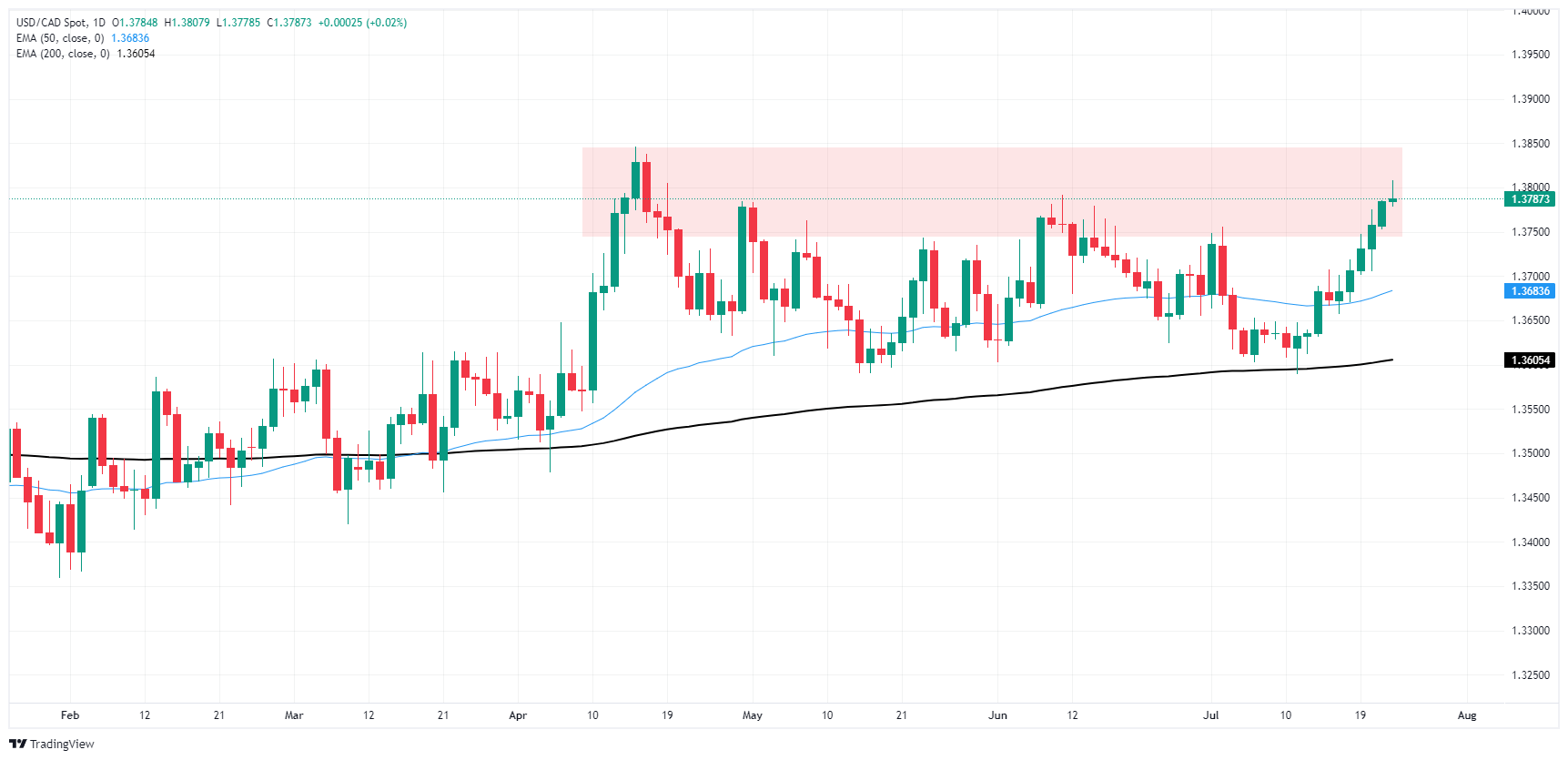- The Canadian Dollar struggles to hold flat against the Greenback after initial slide.
- Canada is headed for an uncertain growth patch as forecasts get revised lower.
- Mixed US PMIs also complicate the picture as the rest of the week looms large.
The Canadian Dollar (CAD) briefly slipped to a 14-week low against the Greenback after the Bank of Canada (BoC) cut rates by another 25 basis points, as markets broadly expected. Further downside revisions to the BoC’s Canadian growth forecasts hobbled the Canadian Dollar, and the USD/CAD pair is posed for a second straight week of gains.
Canada has delivered another rate cut, in-line with the BoC’s own promises of “a series of cuts” in the second half of 2024, but CAD traders are having a difficult time shrugging off steep downside adjustments to Canadian Gross Domestic Product (GDP) growth forecasts as well as a sharp Q1 revision. On the US side of things, US Purchasing Managers Index (PMI) figures came in mixed, with Manufacturing activity contracting and Services unexpectedly expanding to its highest level since April of 2022. Key US data will continue through the week, with US GDP on the docket for Thursday and US Personal Consumption Expenditure Price Index (PCE) inflation slated for Friday.
Daily digest market movers: BoC delivers expected cut, but revises growth forecasts lower
- As markets broadly expected, the BoC cut benchmark rates by a quarter-point to 4.5%.
- What surprised CAD traders was a steep downside revision in the BoC’s growth forecasts, which now expects 2024 GDP to grow by 1.2% for the year compared to April’s forecast 1.5%, an already-low figure.
- The BoC also sees 2024’s first-quarter growth at just 1.7% on an annualized basis, far lower than the previous forecast of 2.8%.
- BoC's Governor Macklem: Monetary policy is still restrictive
- US PMIs came in fiercely mixed, with Manufacturing PMI figures sinking into contraction territory while Services PMI activity surged to a 26-month high.
- Read more: US S&P Global Manufacturing PMI slumps to 49.5
Canadian Dollar PRICE Today
The table below shows the percentage change of Canadian Dollar (CAD) against listed major currencies today. Canadian Dollar was the strongest against the Australian Dollar.
| USD | EUR | GBP | JPY | CAD | AUD | NZD | CHF | |
|---|---|---|---|---|---|---|---|---|
| USD | 0.03% | -0.13% | -1.34% | 0.00% | 0.25% | 0.21% | -0.80% | |
| EUR | -0.03% | -0.17% | -1.40% | -0.01% | 0.23% | 0.22% | -0.85% | |
| GBP | 0.13% | 0.17% | -1.23% | 0.13% | 0.39% | 0.36% | -0.69% | |
| JPY | 1.34% | 1.40% | 1.23% | 1.40% | 1.63% | 1.59% | 0.55% | |
| CAD | -0.01% | 0.01% | -0.13% | -1.40% | 0.25% | 0.23% | -0.82% | |
| AUD | -0.25% | -0.23% | -0.39% | -1.63% | -0.25% | -0.03% | -1.04% | |
| NZD | -0.21% | -0.22% | -0.36% | -1.59% | -0.23% | 0.03% | -1.04% | |
| CHF | 0.80% | 0.85% | 0.69% | -0.55% | 0.82% | 1.04% | 1.04% |
The heat map shows percentage changes of major currencies against each other. The base currency is picked from the left column, while the quote currency is picked from the top row. For example, if you pick the Canadian Dollar from the left column and move along the horizontal line to the US Dollar, the percentage change displayed in the box will represent CAD (base)/USD (quote).
Technical analysis: CAD wobbles but so far holds steady against Greenback
The Canadian Dollar (CAD) is a mixed bag on Wednesday, finding scant gains against the Antipodeans while falling back against the still-recovering Japanese Yen. Chart churn on economic data releases has also left the CAD swimming in circles against the Greenback. The CAD gained around one-fifth of one percent against the Australian Dollar (AUD) and the New Zealand Dollar (NZD), but shed one-and-one-half percent against the Japanese Yen (JPY).
USD/CAD briefly rose to a 14-week high on Wednesday, crossing over the 1.3800 handle before settling back into the day’s opening range. Intraday price action is still holding north of 1.3780, but momentum is leaning increasingly in favor of Greenback buyers.
Daily candlesticks are buried in the middle of a heavy supply zone priced in above 1.3750, and a bearish turnaround from here could send USD/CAD tumbling backto the 200-day Exponential Moving Average (EMA) at 1.3609.
USD/CAD hourly chart
USD/CAD daily chart
Canadian Dollar FAQs
The key factors driving the Canadian Dollar (CAD) are the level of interest rates set by the Bank of Canada (BoC), the price of Oil, Canada’s largest export, the health of its economy, inflation and the Trade Balance, which is the difference between the value of Canada’s exports versus its imports. Other factors include market sentiment – whether investors are taking on more risky assets (risk-on) or seeking safe-havens (risk-off) – with risk-on being CAD-positive. As its largest trading partner, the health of the US economy is also a key factor influencing the Canadian Dollar.
The Bank of Canada (BoC) has a significant influence on the Canadian Dollar by setting the level of interest rates that banks can lend to one another. This influences the level of interest rates for everyone. The main goal of the BoC is to maintain inflation at 1-3% by adjusting interest rates up or down. Relatively higher interest rates tend to be positive for the CAD. The Bank of Canada can also use quantitative easing and tightening to influence credit conditions, with the former CAD-negative and the latter CAD-positive.
The price of Oil is a key factor impacting the value of the Canadian Dollar. Petroleum is Canada’s biggest export, so Oil price tends to have an immediate impact on the CAD value. Generally, if Oil price rises CAD also goes up, as aggregate demand for the currency increases. The opposite is the case if the price of Oil falls. Higher Oil prices also tend to result in a greater likelihood of a positive Trade Balance, which is also supportive of the CAD.
While inflation had always traditionally been thought of as a negative factor for a currency since it lowers the value of money, the opposite has actually been the case in modern times with the relaxation of cross-border capital controls. Higher inflation tends to lead central banks to put up interest rates which attracts more capital inflows from global investors seeking a lucrative place to keep their money. This increases demand for the local currency, which in Canada’s case is the Canadian Dollar.
Macroeconomic data releases gauge the health of the economy and can have an impact on the Canadian Dollar. Indicators such as GDP, Manufacturing and Services PMIs, employment, and consumer sentiment surveys can all influence the direction of the CAD. A strong economy is good for the Canadian Dollar. Not only does it attract more foreign investment but it may encourage the Bank of Canada to put up interest rates, leading to a stronger currency. If economic data is weak, however, the CAD is likely to fall.
Information on these pages contains forward-looking statements that involve risks and uncertainties. Markets and instruments profiled on this page are for informational purposes only and should not in any way come across as a recommendation to buy or sell in these assets. You should do your own thorough research before making any investment decisions. FXStreet does not in any way guarantee that this information is free from mistakes, errors, or material misstatements. It also does not guarantee that this information is of a timely nature. Investing in Open Markets involves a great deal of risk, including the loss of all or a portion of your investment, as well as emotional distress. All risks, losses and costs associated with investing, including total loss of principal, are your responsibility. The views and opinions expressed in this article are those of the authors and do not necessarily reflect the official policy or position of FXStreet nor its advertisers. The author will not be held responsible for information that is found at the end of links posted on this page.
If not otherwise explicitly mentioned in the body of the article, at the time of writing, the author has no position in any stock mentioned in this article and no business relationship with any company mentioned. The author has not received compensation for writing this article, other than from FXStreet.
FXStreet and the author do not provide personalized recommendations. The author makes no representations as to the accuracy, completeness, or suitability of this information. FXStreet and the author will not be liable for any errors, omissions or any losses, injuries or damages arising from this information and its display or use. Errors and omissions excepted.
The author and FXStreet are not registered investment advisors and nothing in this article is intended to be investment advice.
Recommended content
Editors’ Picks
EUR/USD holds near 1.0850 after US PMI data

EUR/USD holds steady at around 1.0850 in the second half of the day on Wednesday. The mixed US PMI data limits the US Dollar's gains but the risk-averse market atmosphere doesn't allow the pair to gather recovery momentum in the American session
GBP/USD recovers above 1.2900 as USD struggles to gather strength

GBP/USD trades modestly higher on the day above 1.2900 on Wednesday. The US Dollar struggles to build on Tuesday's gains following the mixed PMI data for July, allowing the pair to stay in positive territory in the second half of the day.
Gold retains modest gains ahead of key US headlines

Gold builds on Tuesday's recovery gains and trades above $2,420 on Wednesday. The pullback seen in the 10-year US Treasury bond yield and the US Dollar after US PMI data help XAU/USD stretch higher during the American trading hours.
Bitcoin price volatility expected amid speculation of Kamala Harris joining Bitcoin Conference with Donald Trump

Bitcoin price struggles around $66,000 on Wednesday. US spot Bitcoin ETFs experienced minor outflows on Tuesday, coinciding with the continued movement of Mt. Gox funds for repayment, which could exert downward pressure on Bitcoin's price.
July PMIs point to a very sluggish Eurozone recovery

This is another report that will not please the ECB. The July PMIs show that the eurozone economy is losing further momentum, as both the manufacturing and services sectors see activity slowing.